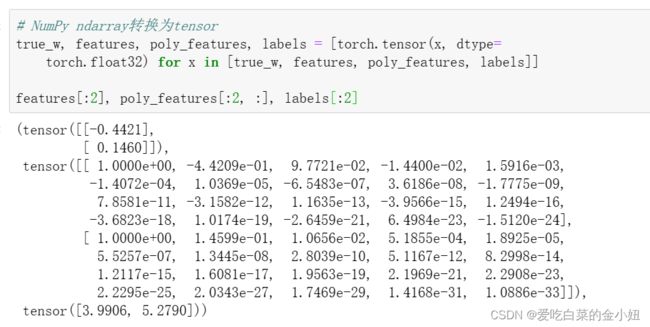【Dive into Deep Learning |动手学深度学习(李沐)】4.4 模型选择、欠拟合和过拟合--学习笔记
目录
- 训练误差和泛化误差
-
- 验证数据集和测试数据集
-
- K-折交叉验证
- 小结
- 过拟合和欠拟合
-
- VC维
-
- 线性分类器的VC维
- 数据复杂度
- 小结
- 代码实现
-
- 生成数据集
- 对模型进行训练和测试
- 三阶多项式函数拟合(正常)
- 线性函数拟合(欠拟合)
- 高阶多项式函数拟合(过拟合)
- 总结
训练误差和泛化误差
- 训练误差:模型在训练数据上的误差
- 泛化误差:模型在新数据上的误差
我们更关注泛化误差,而非训练误差。
验证数据集和测试数据集
- 验证数据集:一个用来评估模型好坏的数据集。
- 测试数据集:只用一次的数据集。
还有一个训练数据集,用来训练模型;验证数据集是用来验证模型的好坏,从而进行模型优化;而测试数据集是最终用来评定模型的数据集。举个例子,训练数据集就是平时为了考试而做的题,验证数据集就是模拟考比如月考、期中考,测试数据集则代表了最终的考试。
K-折交叉验证
在没有足够多数据时使用

如下图所示,3-折交叉验证,分别选取第1、2、3块数据作为验证集,其余作为训练集。

小结
- 训练数据集:训练模型参数
- 验证数据集:选择模型超参数
- 非大数据集上通常使用k-折交叉验证
过拟合和欠拟合
VC维
- 统计学习理论的一个核心思想
- 对于一个分类模型,VC等于一个最大的数据集的大小,不管如何给定标号,都存在一个模型对它进行完美分类。
换句话说,VC维是函数类可以拟合的样本的最大数量。
具体来说,给定一个二分类函数类,如果存在一个大小为d的样本集合,这个函数类能够对这个集合中的任意标签进行正确分类,而不能对大小为d+1的样本集合进行正确分类,那么这个函数类的VC维就是d。
线性分类器的VC维
2维输入的感知机,VC维=3;它能够分类任何三个点,但不是4个(XOR)
- 支持N维输入的感知机的VC维是N+1
- 一些多层感知机的VC维O(Nlog2N)
- 提供一个模型为什么好的理论依据
- 它可以衡量训练误差和泛化误差之间的间隔
- 但是深度学习中很少使用
- 衡量不是很准确
- 计算深度学习的VC维很困难
数据复杂度
小结
- 模型容量需要匹配数据复杂度,否则可能导致欠拟合和过拟合
- 统计机器学习提供数学工具来衡量模型复杂度
- 实际中一般靠观察训练误差和验证误差
代码实现
生成数据集
导包
import math
import numpy as np
import torch
from torch import nn
from d2l import torch as d2l
max_degree = 20 # 多项式的最大阶数
n_train, n_test = 100, 100 # 训练和测试数据集大小
true_w = np.zeros(max_degree) # 分配大量的空间
true_w[0:4] = np.array([5, 1.2, -3.4, 5.6])
features = np.random.normal(size=(n_train + n_test, 1))
np.random.shuffle(features)
poly_features = np.power(features, np.arange(max_degree).reshape(1, -1))
for i in range(max_degree):
poly_features[:, i] /= math.gamma(i + 1) # gamma(n)=(n-1)!
# labels的维度:(n_train+n_test,)
labels = np.dot(poly_features, true_w)
labels += np.random.normal(scale=0.1, size=labels.shape)
# NumPy ndarray转换为tensor
true_w, features, poly_features, labels = [torch.tensor(x, dtype=
torch.float32) for x in [true_w, features, poly_features, labels]]
features[:2], poly_features[:2, :], labels[:2]
对模型进行训练和测试
def evaluate_loss(net, data_iter, loss): #@save
"""评估给定数据集上模型的损失"""
metric = d2l.Accumulator(2) # 损失的总和,样本数量
for X, y in data_iter:
out = net(X)
y = y.reshape(out.shape)
l = loss(out, y)
metric.add(l.sum(), l.numel())
return metric[0] / metric[1]
函数的逻辑如下:
- 初始化一个metric变量,它是一个d2l.Accumulator对象,用于累加损失的总和和样本数量。
- 对于数据集中的每个样本,通过data_iter迭代器遍历。 将样本X输入模型net,得到输出out。
- 由于y的形状可能与out不一致,需要通过y.reshape(out.shape)调整y的形状。
- 使用损失函数loss计算模型在当前样本上的损失值l。
- 使用metric.add(l.sum(),l.numel())将当前损失值和样本数量累加到metric中。
- 最后,返回平均损失值,即metric[0] / metric[1],其中metric[0]表示损失的总和,metric[1]表示样本的数量。
训练函数
def train(train_features, test_features, train_labels, test_labels,
num_epochs=400):
#损失函数为均方误差损失函数
loss = nn.MSELoss(reduction='none')
input_shape = train_features.shape[-1]
# 不设置偏置,因为我们已经在多项式中实现了它
net = nn.Sequential(nn.Linear(input_shape, 1, bias=False)) #线性模型
batch_size = min(10, train_labels.shape[0]) #小批量数据的大小
#加载训练集和测试集的数据
train_iter = d2l.load_array((train_features, train_labels.reshape(-1,1)),
batch_size)
test_iter = d2l.load_array((test_features, test_labels.reshape(-1,1)),
batch_size, is_train=False)
#优化函数
trainer = torch.optim.SGD(net.parameters(), lr=0.01)
#可视化的动画
animator = d2l.Animator(xlabel='epoch', ylabel='loss', yscale='log',
xlim=[1, num_epochs], ylim=[1e-3, 1e2],
legend=['train', 'test'])
#开始每轮训练
for epoch in range(num_epochs):
d2l.train_epoch_ch3(net, train_iter, loss, trainer)
if epoch == 0 or (epoch + 1) % 20 == 0:
animator.add(epoch + 1, (evaluate_loss(net, train_iter, loss),
evaluate_loss(net, test_iter, loss)))
print('weight:', net[0].weight.data.numpy())
loss = nn.MSELoss(reduction='none')PyTorch中的均方误差(Mean Squared Error,MSE)损失函数的定义。其中,reduction参数设置为’none’表示不进行降维操作。
reduction参数控制损失函数的降维方式,有以下选项:
- ‘none’:不进行降维,返回与输入形状相同的张量,每个元素表示对应样本的均方误差。
- ‘mean’:将所有样本的均方误差求平均,返回一个标量。
- ‘sum’:将所有样本的均方误差求和,返回一个标量。
三阶多项式函数拟合(正常)
# 从多项式特征中选择前4个维度,即1,x,x^2/2!,x^3/3!
train(poly_features[:n_train, :4], poly_features[n_train:, :4],
labels[:n_train], labels[n_train:])
线性函数拟合(欠拟合)
# 从多项式特征中选择前2个维度,即1和x
train(poly_features[:n_train, :2], poly_features[n_train:, :2],
labels[:n_train], labels[n_train:])
高阶多项式函数拟合(过拟合)
# 从多项式特征中选取所有维度
train(poly_features[:n_train, :], poly_features[n_train:, :],
labels[:n_train], labels[n_train:], num_epochs=1500)
总结
- 欠拟合是指模型无法继续减少训练误差。过拟合是指训练误差远小于验证误差。
- 由于不能基于训练误差来估计泛化误差,因此简单地最小化训练误差并不一定意味着泛化误差的减小。机器学习模型需要注意防止过拟合,即防止泛化误差过大。
- 验证集可以用于模型选择,但不能过于随意地使用它。
- 我们应该选择一个复杂度适当的模型,避免使用数量不足的训练样本。












